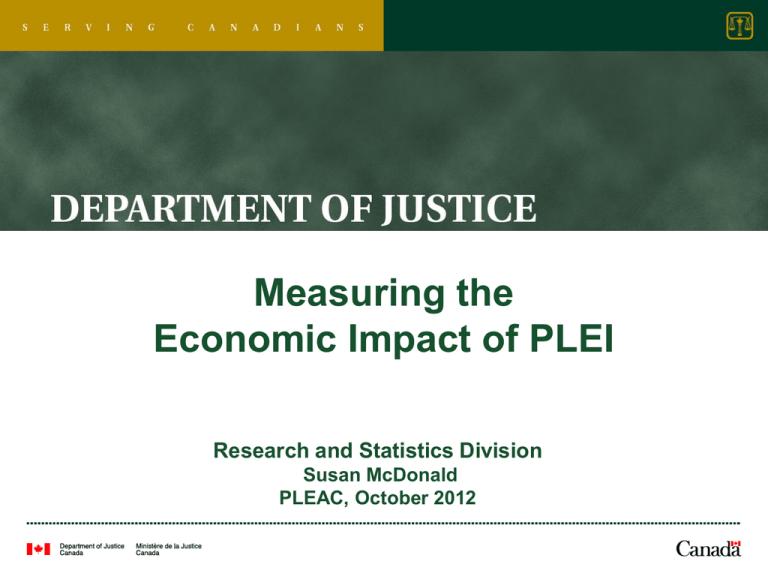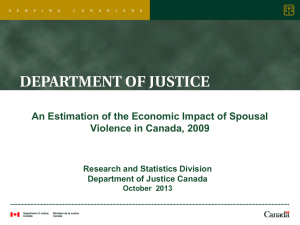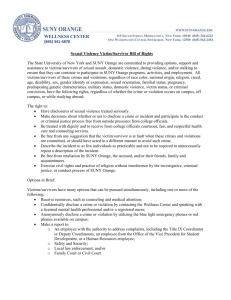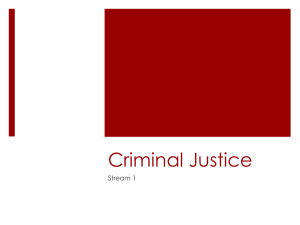1. Evaluating for Impact - Susan McDonald
advertisement

Measuring the Economic Impact of PLEI Research and Statistics Division Susan McDonald PLEAC, October 2012 The Department of Justice as Funder • The Department provides annual funding in each province to 1 organization • • whose designation is recommended by the province. In the Yukon, Northwest Territory and Nunavut, PLEI is funded through the Access to Justice Agreements between the respective governments and the Department. The Department also provides PLEI project funding to non-governmental organizations from: The Justice Partnership and Innovation Program; the Victims Fund; the Family Violence Initiative; the Youth Justice Fund; the Supporting Families Fund; the Aboriginal Justice Strategy Fund; and the Access to Justice in Both Official Languages Support Fund. 2 Current Work on Costing 1) Costs of Crime, 2008 http://canada.justice.gc.ca/eng/pi/rs/reprap/2011/rr10_5/rr10_5.pdf 2) The Costs of Firearm-related Crime in Canada, 2008 3) Spousal violence (ex and current spousal abuse); 4) Non-spousal violent victimization – homicide, sexual assault, assault, robbery, criminal harassment; disaggregated by gender 5) The Economic Impact of Youth Crime on the Criminal Justice System 3 Impact Categories Impacts borne by Justice System Criminal Justice System Civil Justice System Impacts borne by Primary Victims Health Care Productivity Losses Intangible Costs Mental Health Care Other Personal Costs Impacts borne by Other Individuals and Systems Funeral Services Other People Harmed/Threatened Loss to Employers Negative Impact on Children Exposed to violence 4 Loss of Affection/Enjoyment to Family Members Social Services Other Government Expenditures Data Sources 2009 General Social Survey, Cycle 23 Uniform Crime Reporting Survey 2 Examples of other major data sources: Police Administration Survey Adult Criminal Court Survey Court Personnel and Expenditure Survey (CPES) Adult Correctional Services Survey (ACS) and the Integrated Correctional Services Survey (ICS) National Ambulatory Care Reporting System Discharge Abstract Database National Physician Database Government finance reports Existing literature, studies and government reports 5 Key Challenges Lack of data/information Lack of access to data Limitations of the General Social Survey Limitations of small, non-representative studies 6 Spousal Violence: Number of Incidents and Victims – The Attrition Pyramid V. Convictions 11,373 – no victim information IV. Court cases 21,599 – no victim information III. Incidents cleared by charge (UCR2, 2009): 34,859 with 33,809 victims II. Incidents reported to police (UCR2, 2009): 46,918 I. Self-reported incidents (GSS, 2009): 942,000 with 335,697 victims – by gender 7 Summary 1: Who is bearing the IMPACTS? Total estimated costs of spousal violence in Canada: Impact borne by third-party $890 (12.0%) Justice System Primary Victims Third-Party Impact borne by Justice System $545 (7.3%) Impact borne by victims $5,985 (80.7%) Third-party Justice System Victims About 60.6% of the total costs attributable to intangible costs for primary victims and family members About 63.7% of costs attributable to spousal violence against females 8 Summary 2: Who is paying the COSTS? Total tangible costs (excluding negative impact on children exposed to spousal violence) -- actual financial transactions were made For the tangible costs, 78.8% attributable to spousal violence against females Lost Future Income to Children $228 M (3.1%) Intangible Costs $5,497 M (74.1%) Individual 29.4% Tangible Costs $1,695 M (22.8%) State 63.8% 9 Private sector 6.9% ANNUAL CRIMINAL JUSTICE ISSUE EXCLUSIVE RATINGS Over 200 Crime–Related Programs and Policies Washington State Institute for Public Policy Publications: www.wsipp.wa.gov Reports Are Available on: Criminal Justice Juvenile Justice Child Welfare Education Mental Health Substance Abuse Prevention …More on the way S Programs programs taxpayer dollars programs that reduce crime and save taxpayers money. BEST 2011 Crime Policies to Adopt A Framework for Estimating the Economic Impact of PLEI • Locate and meta-analyze all reasonably rigorous outcome evaluations conducted from similar countries (UK, Canada, US, Australia). • • Calculate, on average, impact of PLEI activities on five domains. Without PLEI, economic impact will cost $X ( ); With PLEI, economic impact with legal problem will cost $Y ( ). • Reduced economic impact = net benefit for justice system, citizen and third parties: Estimate that PLEI costs $X per participant; benefits include total $X to taxpayers (lower justice costs), $X to citizens and $X to third parties. A total benefit-to-cost ratio of $X to $Y. • Risk: About X% of the time you lose money (costs exceed benefits). Run the model 500 times testing the expected bottom line for the known or estimated risk and uncertainty in our findings. 11 Evaluations Challenges in PLEI evaluations 1) assess changes in knowledge attitudes, skills, confidence and behaviours; 2) attribute any change to a specific PLE project or program, in other words to ascribe impact to a PLE activity To demonstrate a change will generally require: 1) A baseline measure and a follow-up measure of participants that tests specific areas of knowledge, skills, etc., or asks participants to assess their own level of knowledge, skills, etc. 2) Similar measures with a control or comparison group to identify whether any change is the result of the intervention. 3) To demonstrate whether knowledge, skills, etc. are actually used by participants to prevent or deal with legal issues in the future requires longitudinal research, e.g. participants are followed up three months after the intervention. 12 Questions? The Team Ting Zhang, PhD Josh Hoddenbagh, MA Katie Scrim, BA Susan McDonald, LLB, PhD Principal Researcher Research and Statistics Division Department of Justice Canada 284 Wellington, 6th Floor Ottawa, ON K1A OH8 Tel: (613) 957-9315 Email: smcdonal@justice.gc.ca 13









